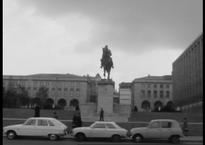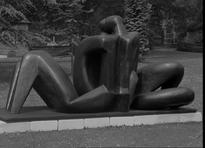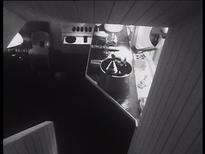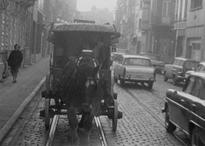JEF CORNELIS
What Jef Cornelis considers the most important principle behind his work is that it adds something worth seeing to what we look at. At the core of his effort lies a tumultuous relationship between visual art and television, a medium for which he directed films between 1964 and 1998. Cornelis' oeuvre was made possible by television broadcasting, but the relationship has always been an ambivalent one. Although he made over a hundred films, including films on modern art, architecture and the Flemish landscape, Cornelis' work is primarily a dissection of television itself, the very medium in which he worked. In 1963, after studying set design and film direction at the Netherlands' Film Academy in Amsterdam, Jef Cornelis began his career as a director for the Arts Division of BRT Television in Flanders, which would later become VRT broadcasting. From the beginning, there was a 'friction', a 'misunderstanding'. In 1964, director Cornelis claimed that Flemish image-makers were still operating at the 'parish hall' level: amateur amusement provided by ignorant producers for underdeveloped viewers. At that time, there were few people in television production who were in fact familiar with or able to handle the language of television. Jef Cornelis, however, together with Alain Resnais, Jean-Luc Godard and Alexandre Astruc, belonged to what was then a relatively new tradition, but one which was already gaining international recognition. Television basically sets out to chat, entertain and amuse the majority. Beyond this, it is by definition a voice that announces and explains what we are about to see. Jef Cornelis perceives himself as a parasite, one who uses that system to do his own work: his films lie beyond these co-ordinates. Cornelis worked within a broadcasting system that paid great heed to 'the average man' and to viewer statistics, and it was this restrictive character of the medium that formed the cornerstone of Cornelis' work. Only within the reformist system of a mass medium could he make films that could be termed 'parasitic' or 'marginal'. Although Cornelis' extensive body of work falls into three general categories - his favourite themes of the architecture and landscape of Flanders, the fine arts and the medium of television - his work interwove varying focal points, principles and techniques. To a lesser degree, Cornelis' films also cover literature, opera and music. Through the years, an outspoken idealist evolved into a pure-blooded television artist. For his early films on architecture, Cornelis joined forces with scenario writer Geert Bekaert. In works such as ‘Home Sweet Home’ (1968) or ‘Bouwen in België’ ('Building in Belgium', 1971), his direction took a critical stance against the framework within which it operated. He filmed the Flemish landscape with great love, investing remarkable efforts to achieve a worthy visual and cinematographic result. Cornelis' films were neither fictional nor documentary reports, but aimed more for a form of essay. His camera direction in particular can be described as exploring or feeling its way, more than actually directing or presenting conclusions. His earliest work showed the young Cornelis as an idealist, ironic in his handling of public domain (his point of reference for Flemish architecture was a dovecote), and his commentaries were those of a man out to improve the world. His first years at work also revealed Cornelis' engagement with the fine arts. In the late 1960s, the young director made short films on ‘Documenta 4’ (1968), ‘Sonsbeek 86’ (1986) and other art events for programmes on contemporary art. In dialogue with who were then, young but established artists, such as Joseph Beuys or Christo, Cornelis played the devil's advocate, donning the shoes of the uncomprehending 'homme moyen'. Brimming with honesty and veiled irony, Cornelis made no bones about interrogating artists on the whys and wherefores of their actions. In contrast to this pretended adversity, Cornelis was personally very involved in contemporary art. He was fascinated by the activities of artists such as Broodthaers and Panamarenko , and in addition to filming unique of portraits of them, by the late 1960s, his engagement had extended well beyond the camera. In 1969, Cornelis was one of the founders of A 379089, an alternative art centre in Antwerp that declared itself an 'anti-museum' or 'anti-gallery'. Together with A 379089's co-ordinator, Casper König, Cornelis organised presentations with Carl André, Marcel Broodthaers, Jörg Immendorf, La Monte Young and Panamarenko. Cornelis' association with art has in fact been just as ambivalent as his relationship with the medium of television; there have been great leaps between intense love and hate. Cornelis set his contemporary art activities aside in 1972, only to pick them up again later, in the 1980s.In the 1970s, Cornelis and Bekaert had meanwhile discovered the helicopter as a technically useful tool for the camera. This resulted in a series of films, with ‘Vlaanderen in Vogelvlucht’ ('A bird's eye view of Flanders', 1976) and ‘Rijksweg I’ ('Highway I', 1978) amongst the most memorable, which find the director and writer flying over the Flemish landscape. From the perspective of flight, Cornelis' odes to these landscapes, to ordinary people and their everyday lives, are supported by texts and interspersed with numbers. In the late 1970s, at the time that he was making his 'helicopter films', public television was engaged in its first conflict between 'numbers of viewers' and the demand for quality television. For Cornelis, the circumstances provided an incentive to expand his horizons. He began dealing with television at its most basic level, as a means of communication and a vehicle for conveying information. As early as the beginning of the 1980s, Cornelis was already being labelled a 'television artist'. His broadcasts were about communication, or the lack thereof. The 'subject' of the programme was simply a supporting layer, the vehicle for his analyses of larger-level communications. By this time, Cornelis’ focus was the talk show format, and he was exceptionally creative in applying its imperatives. For his ‘IJsbreker’ ('Managing Culture', 1983-'84) programme, he used satellite links, very advanced technology for the period. What were then the early stages of modern prying techniques, were for Cornelis a module to speed up his switching between various ideas and discussions. The result was confusion: the conversations, taking place at different locations, got completely out of hand and left the viewer wondering what was going on. With ‘Container’ (1989) - a truly legendary television programme, which a major smear campaign managed to take off the air after the first broadcast - Cornelis formally embarked on a new road. The programme was based on an extremely simple, unvaried concept: its maker herded a number of young thinkers together in a small container, in order to hold an uninterrupted conversation. Cornelis again managed to create confusion, and not only because his guests interrupt one another and all talk at once about matters far removed from the lives of the 'average man'. The visible layer of the subject under discussion once again had little relevance. ‘Container’ is first and foremost about exposing a medium. Cornelis demonstrates 'misunderstandings' that generally are not, or may not be, dealt with on television. The stammering moderator, searching about for a new question to ask, the nervous guest fiddling with his pen or the persistent babble of a speaker in mid-shot: in ‘Container’, Cornelis does not mask the shortcomings of his medium, but isolates and emphasises them. It is self-evident that given the television norm, such a recalcitrant programme would not be destined for longevity. As a whole, Cornelis' later programmes stand out as a solid resistance to the standard language of his medium, stranded as it was in pure amusement. His work opposed the conditions imposed by that medium and mercilessly poked holes in the illusions it generated. Around 1985, Cornelis was once again engaged in the fine arts, aware that the artists whom he had interviewed in the 1960s and 1970s were now active on a wider, international stage. Cornelis' renewed interest led him, amongst other things, to curate exhibitions for the Witte de With Center for Contemporary Art in Rotterdam, where in 1995, he presented an exhibition on the correlations between cinema and the fine arts. As a whole, the work of Jef Cornelis comprises a headstrong, unique chronicle of modern and contemporary art since 1960, a history of art that strove unanimously for change, and whose social attitude has significantly contributed to circumstances we experience today. Cornelis' documentaries have moreover lost none of their relevancy. They are prime examples of analytical perception, reaching far beyond the standard parameters of journalism. Cornelis looks beyond the historical information and the nostalgic anecdote in order to present effective essentials. It consequently makes no sense to consider Cornelis' filmmaking simply in terms of the television medium. It is a body of work that belongs amongst the most valuable cinematography that Flanders has ever produced.






- ° 1941 Antwerp (Belgium).
- † 2018 Antwerp (Belgium).
-
Links
-
EVENTS
- Jef Cornelis TV Works: M Leuven
- argos @ 16th Line Gallery
- James Lee Byars - From Life to Art and Back Again
- Paris-Bruxelles
- Over Haven- en textielarbeider
- James Lee Byars
- Pop Art in Belgium
- Herbert Event #2
- New Stories for Brussels. Strategies for a Dissident Reading of the City. On the image of the Belgian capital in recent video art.
- Video Library
- Sven Sterken: New Stories for Brussels. Strategies for a dissident Imagination of the City
- Jef Cornelis : Kunst is voor weinigen (Art is for the few)
- Een weekend met mijnheer Magritte
- Architectural Trilogy
- Flanders roads
- Jef Geys: Quadra Medicinale Singapore
- Travelling in South America
- FIAC 2015: Sonsbeek 1986
- Looking back - A video selection from the Argos collection for Contour On Tour: Video art in the Flemish Parliament
- Daniel Buren - Le Décor et son Double
- Strolling Around
- Jef Cornelis & René Magritte
- Inside the White Tube. A retrospective view on the television work of Jef Cornelis
- Vlaamse Landschappen
- BlackThursday - Television is the message: visual art in the work of Jef Cornelis
- Making sense in the city - 2006
- COM nu TIES seuils/drempels/thresholds - A duoshow with ISELP
- WEG VAN VLAANDEREN
- Less is More: Pictures, Objects, Concepts from the Collection and Archive of Herman and Nicole Daled 1966–1978
- Brussels Biennale of Modern Architecture
- L'arte di rivelare l’arte: Il caso Jef Cornelis
- James Lee Byars
- Private View. Jef Cornelis on art events
- Archives - Screenings of documentaries by Jef Cornelis
- Alexander Kluge and Jef Cornelis in discussion with Paul Willemsen
- Art in the Sixties
- Jef Cornelis @ Tate
- Portraits of the poet
- Erfgoeddag 2011: The canal neighbourhood: my world? The past and prospects of a Brussels neighbourhood
- Charles Vandenhove
- Communities
- Lectures by Koen Brams and Dirk Pültau on the work of Jef Cornelis
- Documenta 5
- Jef Cornelis - De Langste Dag
- Jef Cornelis @ Essay Film Festival
- James lee Byars 1/2 Autobiography
- A 37 90 89 – Die Erfindung der Neo-Avantgarde
- Liverpool Biennial 2014 - Jef Cornelis
- Charles Vandenhove
- Five artists from the archives and collection of Jan Hoet
- Flanders roads
- Jef Cornelis TV Works: Cinema Zuid
- Belgian architecture
- Waarover men niet spreekt
- Portraits of the poet
- Waarover men niet spreekt
- Art in the Sixties
- Jef Cornelis TV Works 1960–80
- Sonsbeek 1971-1986
- Documenta 4-6. Art, Media and the Antinomies of Mega-Art events
- Jef Cornelis @ School of the Art Institute of Chicago
- O.M.A. Rem Koolhaas
- Jef Cornelis - A screening series in the Cinematek
- Silver Bliss #3: A Certain Love, A Certain Irony, A Certain Belgium
- Over Haven- en textielarbeider
- Travelling in South America
- Into the World, Out on the Street
- Jef Cornelis: Obras para Televisão (1964-1997)
- Argos @ EMST
- Barely There part I
- Jef Cornelis @ South London Gallery
- Vlaamse Landschappen
- rewind productions
- Documenta 4
- Dans le vestibule avec Jef Cornelis
- Un week-end avec Monsieur Magritte
- Dames en heren Jan Fabre
- World Day for Audiovisual Heritage 2016
- Art in Paris in the mid-eighties
- Argos Media Library
- James Lee Byars, The Perfect Kiss
- Sonsbeek 1971-1986
- Jef Cornelis TV works: Extra City / Kunsthal Antwerpen
- 111h31'19" of Television
- Herbert Event #1
- Communities
- Jef Cornelis: Obras para Televisão (1964-1997)
-
At view in the media library
WORKS- 10de Biënnale van Middelheim Antwerpen [1969]
- 11de Biënnale Middelheim Antwerpen, 6 juni - 3 okt. '71
- 3 x KUNSTONDERWIJS
- Abdij van Park Heverlee
- Alden Biezen
- American Library
- Andy Warhol
- Anthony Caro, Pompadour
- Antiekbeurs
- Art Nouveau in Brussel
- A weekend with Monsieur Magritte
- A weekend with Monsieur Magritte, part 1 Saturday
- A weekend with Monsieur Magritte, part 2 Sunday
- Beeldende kunst in België, 1986
- Biennale Middelheim 1971
- Biënnale Sint-Niklaas
- Biënnale van Parijs 1985
- Bob Van Reeth
- Bouwen in België
- Bouwen in België
- Bread and Puppet Theatre
- Bruegel, 11 juli viering
- Brussel, scherven van geluk
- Buenos Aires
- Carlo Van Neste – Vioolvirtuoos
- C'EST MOY QUE JE PEINS, Wie alleen staat heeft recht van spreken
- Charles Vandenhove, La Maison Schoffeniels
- Charles Vandenhove: Le Gymnase Sart-Tilman
- Christo
- Cogels Osylei
- Cogels Osylei, Berchem
- CONTAINER 01: over sentimentaliteit
- CONTAINER 02: tussen waanzin en perfectie
- CONTAINER 03: de puntzak van Heine
- CONTAINER 04: de betoverde wereld van art deco
- CONTAINER 05: het cynisme van Ernest Claes
- CONTAINER 06: de oorsprong van het warenhuis
- CONTAINER 07: over theatraliteit
- CONTAINER 08: over Don Juan
- CONTAINER 09: over roes
- CONTAINER 10: exotismen
- Dagboek van een krankzinnige
- Dames en heren Jan Fabre
- Daniel Buren
- Daniel Buren (Palais Royal)
- David Hockney
- De 10 schilderijen van Etienne Elias
- De achterkamer (Daniël Robberechts)
- De Etrusken (Massimo Pallotino)
- De kleuren van de geest
- De klok slaat vijf: textielarbeider
- De Koninklijke serres van Laken 1877-1902
- De kunst van het verkopen
- De langste dag
- De Nederlandse dagen
- Design Brussel
- De straat
- De trein voorbij
- De zwanen van Roger Raveel [Triënnale Brugge]
- Diamant, handel in vertrouwen
- Dick Bruna
- Documenta 4
- Documenta 5
- Drie blinde muizen
- Edgard Tytgat
- Edward Kienholz
- Een dichter in Texas, H.C. Ten Berge
- Een eeuw architectuur in België 1875-1975
- Een openbaar bad voor Munster
- En wat zullen we over het sterven zeggen
- Etienne Elias
- Europalia Designcenter
- Europalia: Stedelijk Museum Amsterdam 60-70
- Filip Van Snick: Stall-Ology
- FLOWER PLANT, César Bailleux
- François Clouet – Edward Munch (Koninklijke Bibliotheek)
- Frank Van Klingeren (Architect)
- Geestelijke gezondheidszorg (1): het psychiatrisch ziekenhuis
- Geestelijke gezondheidszorg (2): praten met patiënten
- Geestelijke gezondheidszorg (3): "als jullie vriendelijk buitengaan dan is dat bij ons ook over"
- Ge kent de weg en de taal
- George Segal
- Griekenland alles inbegrepen
- Guy Rombouts
- Hedendaagse kerkenbouw op een keerpunt
- Henk Visch
- HET GEDROOMDE BOEK: variaties op "vita brevis" van Maurice Gilliams [English version]
- Het Koninklijk Paleis, Antwerpen, ICC
- Het nieuw Belgisch Kamerorkest
- Het raadsel van de sfinks
- Ijsbreker 01: Panamarenko
- Ijsbreker 02: De cultuur in de krant
- Ijsbreker 03: Dwars-fluitend
- Ijsbreker 04: Kunst te koop
- Ijsbreker 08: Carte blanche aan Franz Marijnen
- Ijsbreker 09: Woensdagavondkoorts: let's dance
- Ijsbreker 10: Laat me (nog eens) lachen
- Ijsbreker 11: Wonen+wonen=2
- Ijsbreker 12: De kunst van het tafelen
- Ijsbreker 13: Culturele centra (kleine)
- Ijsbreker 14: Literaire tijdschriften
- Ijsbreker 15: Goochelen versus parapsychologie
- Ijsbreker 16: Lichamen - toonbeelden
- Ijsbreker 17: Van toeters en blazers
- Ijsbreker 18: Kunst aan de kust
- Ijsbreker 19: Verzamelen van kunstvoorwerpen
- Ijsbreker 20: Computerkunst
- Ijsbreker 21: Mode
- Ijsbreker 22: Cultuurmanagement
- Internationale Meestercursus Liedinterpretatie. Een cursus met Erik en Ady Werba (08/08/1971 – 29/08/1971)
- Jacques Charlier
- James Lee Byars, Antwerpen 18 april – 7 mei 1969
- James Lee Byars: World Question Center
- Jan Brusselmans
- Jan Vercruysse, 1990
- Jeanloup Sieff
- José van Dam
- Kitsch Gillo Dorfles
- Kröller-Müller (ICC Antwerpen)
- KUNST ALS KRITIEK. WANNEER IS KUNST GEEN KRITIEK? 1. Wanneer het woord “kunst“ tot kopen aanzet
- KUNST ALS KRITIEK. WANNEER IS KUNST GEEN KRITIEK? 3. Wanneer het kunstbezit een prestigezaak is
- KUNST ALS KRITIEK. WANNEER IS KUNST GEEN KRITIEK? 4. Wanneer de kunst lichtjes bedwelmt
- KUNST ALS KRITIEK. WANNEER IS KUNST GEEN KRITIEK? 5. Wanneer de meester zegt wat kunst is
- KUNST ALS KRITIEK. WANNEER IS KUNST GEEN KRITIEK? 6. Wanneer de kunst zoet houdt
- KUNST ALS KRITIEK. WANNEER IS KUNST WEL KRITIEK? 1. Wanneer kunst maatschappijbewust maakt
- KUNST ALS KRITIEK. WANNEER IS KUNST WEL KRITIEK? 3. Wanneer een cartoon aan politiek doet
- KUNST ALS KRITIEK. WANNEER IS KUNST WEL KRITIEK? 4. Wanneer de kunstenaar in alle ernst speelt [BRT version]
- KUNST ALS KRITIEK. WANNEER IS KUNST WEL KRITIEK? 4. Wanneer de kunstenaar in alle ernst speelt [NOS version]
- Kunst en Censuur (Groot Kempische Cultuurdagen)
- Landschap van kerken
- L'énigme du sphinx
- Les vacances de Monsieur MAG [Dutch version]
- Les vacances de Monsieur MAG [French version]
- Liliane Vertessen
- Lili Dujourie, Fragmenten en Sculpturen 1972-1982
- LITTLE SPARTA, et in Arcadia ego
- Luister van Spanje
- Marcel Broodthaers °1924
- Marcel Broodthaers – Herman Jacobs
- Marcel Broodthaers: Musée d’art du XVIIe siècle
- Marc Maet
- Marshall McLuhan
- Martial Raysse
- Maurice Béjart (& Mudra)
- Max Bill
- Mens en agglomeratie
- Metamorfose van het Object (1910-1970 PSK Brussel)
- Montevideo
- M'ZAB, Stedelijk wonen in de woestijn
- Na alle vlees: portret van een werkwijze (Jacq Vogelaar)
- Nederlandse architectuur. Het nieuwe bouwen 1920 - 1940
- Niele Toroni
- Objectieve architectuur
- O.M.A. Rem Koolhaas
- Ontmoeting met Design + hedendaagse Britse grafiek
- Oog en hand als uitdrukking 01
- Oog en hand als uitdrukking 02
- Op-Art
- Osaka : 500 pictures of the Osaka Expo 70 by Bruno Suter and Peter Knapp
- Oscar de Wit - tekeningen, teksten
- Ouverture. Castello di Rivoli, 1985
- Panamarenko, Antwerpen 1940
- Patershol, Gent
- Pau Brasil : Je vindt niet, wat je zoekt
- Paul Joostens
- Picasso in Parijs (Heropening Grand Palais)
- Pieter Engels, PARAMARCHE (reverse event)
- Piet Mondriaan
- Pjeroo Roobjee
- Plus d'Honneur que d'Honneurs
- Plus Kern (Gent)
- Pop Art: Casino Knokke
- Profiel van de architect
- Raoul De Keyser
- Raoul De Keyser
- Richard Hamilton
- Richard Hamilton, 15 mei – 28 juni 1970
- Rijksweg N1
- Robert Houben, Minister van Staat
- Roland van den Berghe
- Santiago de Chile
- Sonsbeek Buiten de Perken
- Sotheby's
- Spaziergaenger mit Hund - Sonsbeek 86
- Stanley Brouwn 6 stappen 10x (MTL Gallery Brussel) + Karel Appel
- Tawantinsuyu 1992-1492
- The Music Box
- Theo Van Doesburg [Nelly Van Doesburg]
- The street
- Tredicesima Triennale di Milano
- Triennale Brugge
- Tweede Internationaal Salon der Avant-garde Galerijen Lausanne
- Valerio Adami, Hotel Chelsea Bathroom
- Van Abbemuseum
- Van bassengwerker tot havenarbeider (Antwerpen)
- Verliefde harten of de listen ener jonker
- Vic Gentils: Monument – Camille Huysmans
- Victor Bourgeois
- Vlaanderen 77
- Vlaanderen in vogelvlucht
- Voyage à Paris [English version]
- Waarover men niet spreekt 1: Home sweet home
- Waarover men niet spreekt 2: Alice in wonderland
- Waarover men niet spreekt 3: Een hemel op aarde
- Wat denken ze wel
- Werkgemeenschap 70
- XXXIII BIENNALE INTERNAZIONALE D'ARTE VENEZIA (1966)
-
ARGOS PUBLICATIES